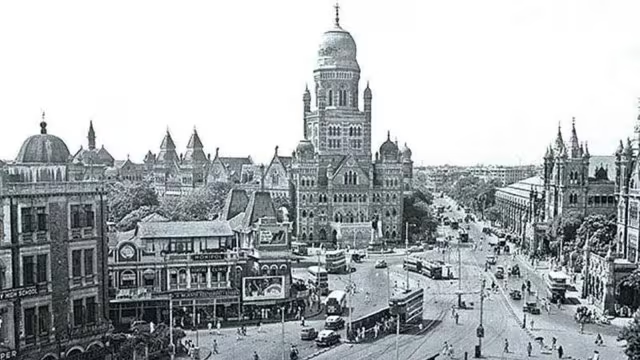Have you ever wondered what the Queen’s Necklace looked like in the 1950s? A 20 x 31.3-inch painting titled Bombay from Malabar Hill by Night by an unidentified artist captures this serene cityscape in hues of black, deep blue, and green. Meanwhile, an 1898 artwork by Pestonji Bomanji portrays three cattle in the foreground, with a small pond and hut-like structure in the background, depicting Dhobi Talao—a neighborhood that once featured a pond where washermen cleaned the clothes of British soldiers.
Currently on display at DAG (formerly Delhi Art Gallery) in Colaba, these paintings are part of the exhibition Once Upon a Time in Bombay, which chronicles the city’s evolution from seven islands to the bustling urban hub it is today. A highlight of Mumbai Gallery Weekend 2025, the showcase features 42 works by artists such as LN Taskar, MS Joshi, AM Mali, GS Haldankar, DC Joglekar, KH Ara, SG Thakar Singh, and travelling European artists.
The exhibition captures iconic landmarks such as the Gateway of India, Banganga, Babulnath Temple, Bassein Fort, Khada Parsi, and Flora Fountain, as well as neighborhoods like Walkeshwar and everyday scenes around temples or the sea. It offers visitors a unique perspective on how these landscapes have transformed since the 19th and 20th centuries.
“It’s a love letter to the city,” says Ashish Anand, CEO and MD of DAG (formerly Delhi Art Gallery), “painted by artists for whom Bombay was a muse”. The exhibition connects the city’s natural beauty—the sea and beaches—with its colonial architecture, sacred sites, and everyday street life.
The exhibition is divided into three sections — Sacred & Storied; By the Sea; and Cityscapes in Time. “By the Sea investigates the quiet seafront of villages and fishermen’s lives, often with the looming city in the background,” said Anand. “Sacred & Storied includes works that explore the city’s striking colonial architecture as well as Indian artists’ attempts to reclaim the ‘Indian’ landscape through expressive watercolors of temple and pilgrimage sites.”
A highlight in this section is an untitled painting by LN Taskar, featuring a Maharashtrian temple scene with women dressed in traditional nauvari sarees and wearing Peshwai Nath.
The exhibition also captures the enduring spirit of the city and its people with a sense of nostalgia, presenting a time when Mumbai was Bombay. “When its once-leafy roads were a little less frenetic, and one could still enjoy a walk on the beach, revel in the flowering of a gulmohar tree, or see fisher boats return to shore with their catch,” said Anand.
Paintings of Banganga by NR Sardesai and KH Ara embody this nostalgia. The diversity of cityscapes is vividly captured in the works of Baburao Sadwelkar and NR Sardesai. His almost rustic depiction in Cuffe Parade — Where Now Stand the Gagalbhoy Baths! reveals a cityscape that is now nearly unrecognisable. Similarly, Sadwelkar’s Excavation in the Mazagaon Area reflects the threshold of modernity, narrating the story of a city in constant transformation.
Anand said, “For me, SG Thakar Singh’s Dusk at the Chowpatty brilliantly represents Bombay through the eyes of an artist who did not belong to the city but came here to accept commissions and paint its views. The painting captures the quality of light when the sun merges with the sea, the reflections in the water, and the people along the shore vividly rendered.”
The exhibition at DAG serves as a prelude to a larger showcase at Sir JJ School of Art, featuring additional works and archival materials like maps, literature, and photographs.
